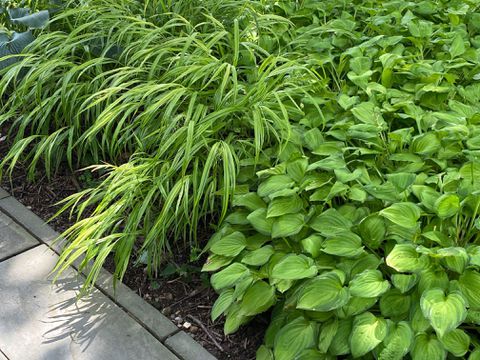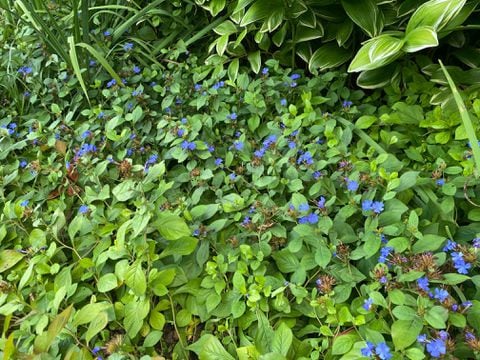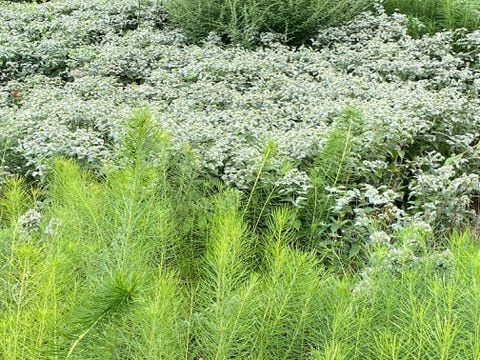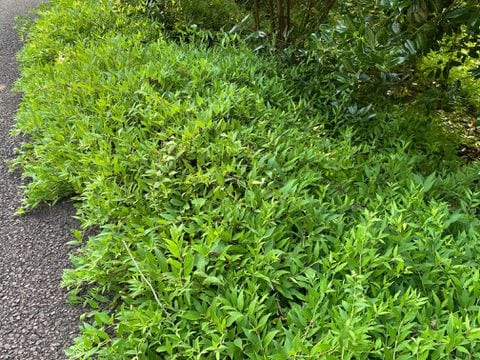With planning and patience, even the tiniest of gardens can be made glorious
A colleague recently enlisted my advice about replanting the front and side yards of his Capitol Hill townhouse. Thankfully, there was little existing vegetation (or he had cleared it already) and it was spared the tired, overgrown fate of many small urban yards.
We are entering prime season for renovating landscapes, and his project got me thinking about what folks need to know about successful makeovers and why so many small gardens go wrong. Before speaking to the right way, let’s imagine the ravages of time on a city garden the size of my colleague’s. His corner lot features an entrance garden of about 20 by 20 feet, bisected by a brick path. The connected side yard is about six feet wide and 25 feet long.
This blank slate seemed primed for a wholesale replanting that would grow into a fresh, beautiful and deeply satisfying landscape. Such a garden would stand out too against all those urban lots whose plantings had grown to blur the original spatial relationships and design intent.
Typically, hedges planted when the “Jurassic Park” film franchise cranked up in 1993 have become themselves menacing dinosaurs. They were originally intended to define the property or to provide screening but are now too broad at the top and too thin at the bottom. Similarly, both deciduous and evergreen shrubs expand into paths and shade out other plants around and beneath them. Time flies, time fudges.
Large trees provide their own conundrum. You don’t want to take down a mature shade tree — and in some jurisdictions are constrained from doing so — but at the same time you shouldn’t live under a constant gloom of shade and tree litter. (The worst offender might be a Southern magnolia.) Often, you can remove the lowest limbs and thin out the canopy to reclaim space and light. This can go badly wrong in several ways, though, and is a job for a competent and qualified certified arborist.
All gardens sag with time, all gardens need constant tweaking and adjustment, but ones that are put together with careful consideration of plant choices will age slowly and even gloriously. After removing old vegetation from the site (and improving the soil) consider my general principles for planting in small gardens:
Don’t plant for instant effect. Perennials and grasses take two to three years to reach established size, ground covers can take as long or longer to fill in, and trees and shrubs should take at least five years to have any real presence. Anything rushed or planted too thickly will come back to bite you. Central to the last point is this: Don’t plant fast-growing trees and shrubs. A variety with an annual growth rate of more than 12 inches (high or wide) would raise a flag to me.
Reduce the number of prospective ornamental trees and shrubs, and regard each one you do plant as a piece of sculpture, to be positioned and spaced with utmost consideration.
[The garden has lessons for us in this quarantine, if we are willing to stop and listen]
All trees and shrubs benefit from sensitive pruning when they are young to direct future growth, and they can be fine-pruned annually to keep them growing where you want them and looking good. But they shouldn’t have to be hacked back after three or four years to fit their space.
 Hostas are a good option for partial shade. Here, Hosta Emerald Tiara is paired with hakone grass, also excellent in shady locations, at Chanticleer Gardens in Pennsylvania. (Adrian Higgins)
Hostas are a good option for partial shade. Here, Hosta Emerald Tiara is paired with hakone grass, also excellent in shady locations, at Chanticleer Gardens in Pennsylvania. (Adrian Higgins) Resist gorging on all your favorite flowering plants, and calm everything by using ground covers for foliage and textural effects. In small city gardens there’s no reason to have open soil; the area is small enough to employ ground cover plants. But space them with care, based on their eventual size. The plant label will give you the correct spacing.
Plant ground covers in blocks that relate to the next. The finer the texture of a ground cover, the more calming it will be, and helpful in reducing everything in scale, which I think is key to a successful small garden.
A layer of mulch no more than two inches deep is fine for neatness and to suppress weeds until the ground covers knit together, but after that there is no reason to automatically lay mulch every spring.
Shrubs are woody plants that keep their leaves year-round, such as camellias, or drop them in the fall, such as hydrangeas. Hardy perennials and grasses, by contrast, die back to the ground each winter and regrow from their submerged crown in the spring. While some can spread, most stay predictably the same size year after year, making them easier to use in small gardens.
One way to effectively reduce the mass of plantings is to minimize the use of shrubs and instead turn to certain perennials with shrublike qualities. They can be used to provide structure and screens. Make sure you have the correct light conditions for the variety you pick.
 Leadwort is an attractive, low-growing ground cover with blue flowers in summer and some red fall coloration. It spreads but can be cut back easily. (Adrian Higgins)
Leadwort is an attractive, low-growing ground cover with blue flowers in summer and some red fall coloration. It spreads but can be cut back easily. (Adrian Higgins) Perennials that function as scaled-down shrubs
False indigo (Baptisia species). This native plant grows to about three feet tall and even wider, and produces flower spikes in late spring in purple, blue, yellow or white, depending on the variety. The foliage is blue-green and handsome.
Bluestar (Amsonia hubrichtii). Three feet tall and almost as wide, the bluestar has small powder-blue blooms in spring but is most valued for its feathery foliage, which turns a golden orange in the fall.
Goldenrod (Solidago species). Three feet by two feet. Goldenrod is a spreading weed in the wild — that would be the species Solidago canadensis — but other species and varieties behave themselves in the garden while bringing sprays of tiny golden flowers in late summer and early fall. And no, this doesn’t cause hay fever.
Joe-Pye weed (Eupatorium purpureum). Another native plant with cultivated varieties for the garden, some bred for compactness. A variety such as Gateway grows to six feet or more but benefits from being cut back in May to promote bushiness.
Swamp rose mallow (Hibiscus moscheutos). This tropical-looking summer perennial is hardy and big — it grows to seven feet. Many varieties have been developed for garden use. It is suited to wet areas.
Aster (Symphyotrichum). Asters vary in habit from 12 inches to six feet, but most are two- to three-foot mounds that act as small shrubs and provide color and ornament through October. Some of the recommended garden varieties are Bluebird, October Skies, Raydon’s Favorite and Purple Dome.
Large-leafed hostas. Small-leafed hostas make effective ground covers in partial shade, but large-leafed varieties function as low, broad shrubs. Such varieties include Sum and Substance, Frances Williams, Blue Angel and Empress Wu.
Ornamental trees
My colleague’s entrance garden could accommodate one tree, perhaps two, but the right selection is vital. These are among the trees people are inclined to think stay small, but don’t: tree-type crape myrtles, and especially Natchez; river birch; Japanese flowering cherries; Chinese fringetree.
There are a number of trees that stay relatively small, at least for their first 20 years. Here are my choices, in no particular order.
Paperbark maple (Acer griseum). Grown for its cinnamon-colored flaking bark, the paperbark maple is upright, pretty and stunning in winter.
Redbud (Cercis canadensis). Forest Pansy is a pretty purple-leafed type of redbud but is overused. Appalachian Red and Tennessee Pink are both improved green-leafed forms, and Hearts of Gold has yellow foliage.
American hornbeam or ironwood (Carpinus caroliniana). Not to be confused with the ubiquitous upright Carpinus betulus, the native tree has muscular silver bark, stays small and benefits from deft formative pruning. Several varieties have been developed for garden use.
Sweetbay magnolia (Magnolia virginiana). With fragrant late-spring flowers and glossy green leaves that are silver-blue underneath, the sweetbay magnolia is a splendid choice. It will grow happily in sun or partial shade but not in poor, dry soil. Some are multiple stemmed, others have single trunks — select the form you want at the nursery. Several improved varieties are available, including Green Mile, Emerald Tower and Keltyk.
Allegheny serviceberry (Amelanchier laevis). This is the most treelike of the shrubby serviceberries. The fruit is edible and the fall leaf color spectacular. Several improved varieties have been introduced, including Snowcloud and Cumulus.
Japanese apricot (Prunus mume). This will give you the flowering cherry effect, but very early (in late winter) and in a more contained tree.
 Where taller plants are desired, the feather-like bluestar can be massed or used singly. Here it is paired with mountain mint. (Adrian Higgins)
Where taller plants are desired, the feather-like bluestar can be massed or used singly. Here it is paired with mountain mint. (Adrian Higgins) Ground covers
Massing plants on ground level provides the base layer for everything else and is the underpinning of any effective garden. We need to move on from three ubiquitous ground covers that have seen their day, in my view: English ivy, pachysandra and vinca.
Ground covers can be shrubs, perennials, grasses and sedges, both evergreen and deciduous. Those that like full sun will take partial shade, but be careful of placing shade lovers in hot, sunny sites. Here are a few I think are effective in small-scale gardens.
Small to midsized ferns are visually quiet but attractive, especially painted ferns and autumn ferns. I favor the following perennials for partial shade: epimedium, leadwort, hellebores, foamflower, cranesbill, mazus and creeping Jenny, along with an array of small-leafed hosta varieties and hardy begonia. In sunny spots, consider mountain mint, calamint, leadwort and the overused but still useful liriope. Massed grasses can look “clumpy,” but little bluestem and northern sea oats provide attractive colonies. In shadier locations, consider hakone grass and some of the fine-textured sedges. The following shrubs work massed: slender deutzia Nikko, smooth hydrangea, sweetbox and skimmia.
If your small garden needs a makeover, the hour has arrived. Planting between now and November will allow plants to get established before the stresses of the next growing season. For an uplifting, close-to-home project that inherently looks to the future, it’s also a form of antidote to the horrors of the moment.
Adrian Higgins is the gardening columnist for The Washington Post.
Designed by Twila Waddy.
 Massing plants on ground level, such as these deutzia Nikko, provides a base layer for everything else in the garden. (Adrian Higgins)
Massing plants on ground level, such as these deutzia Nikko, provides a base layer for everything else in the garden. (Adrian Higgins) 





